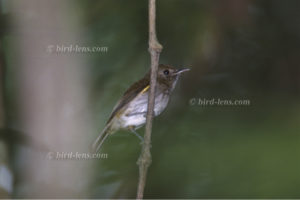 Shortly, the Flammulated Pygmy-Tyrant (Hemitriccus flammulatus) undertakes a sally-strike maneuver to glean arthropod prey from the surfaces of leaves and twigs. Than it sits on a branch. The undergrowth is pitch dark. It is only through its flight-movements that the little bird is noticed. Frequently it vocalizes its high-pitched call. The Flammulated Pygmy-Tyrant is a tiny olive-grey bird – like many species in the family Tyrannidae.
Shortly, the Flammulated Pygmy-Tyrant (Hemitriccus flammulatus) undertakes a sally-strike maneuver to glean arthropod prey from the surfaces of leaves and twigs. Than it sits on a branch. The undergrowth is pitch dark. It is only through its flight-movements that the little bird is noticed. Frequently it vocalizes its high-pitched call. The Flammulated Pygmy-Tyrant is a tiny olive-grey bird – like many species in the family Tyrannidae.
Early in the morning I had woken up. Outside it is still hazy; thick clouds are covering the sky. I decide, I could try to photograph the Flammulated Pygmy-Tyrant. It is humid and the sky remains covered. So I pack my rucksack with a 2.8 / 300 lens and a MZ-5- flash. After just a few meters hike with the rucksack on the back, the shirt sticks to the wet body. The main path through the hotel Flora and fauna grounds of Robin is really a dream. Hilly forest, which still exists with impressive jungle giants. It is called the Ocorotu Forest. I am really impressed. The Flammulated Pygmy-Tyrant can be heard already from the undergrowth. I follow the course of the path that leads down into a brook bed. From there it goes up the hill again. Just at this point a few days ago I encountered the biggest bats I have ever seen. They are probably False Vampire Bat (Vampyrum spectrum)
As the genus-name, Vampyrum, suggests, the False Vampire Bat were mistaken for bloody vampire bats. But they are carnivores that feed on birds, smaller bats and rodents. It is quite dead in the forest, and only on the narrow path, which leads up from the stream, I run into a flock of birds. I step to the path and continue through the dense forest. The Flammulated Pygmy-Tyrant actually calls right at the place Robin described. With the help of a MiniDisk-recording I fix the identity. Obviously, I am in the middle of the bird’s territory. Again and again it sits on a thin branch – unfortunately it is not always the same. It is not impressed by my presence, let alone scared. The Flammulated Pygmy-Tyrant is constantly flying around me. It does not react positively or negatively to the calls from the MD. But it rarely sits quietly, and is not exactly an eye-catcher either; rather inconspicuous. Nevertheless, I can photograph it quite well from about 8 meters distance.
A good starting point to the Ocorotu Forest is the hotel “Flora y Fauna” (coordinates: S 17 29’96”, W 63 39’13”) on the way to Huaytu, branching off from Main Plaza in Buena Vista. 3,7 km from Buena Vista is the small, unpretentious but with a sign-posted entrance on the left. A narrow road leads up to a slope to the hotel. Robin Clarke Gemuseus tries to operate a lodge here in African style. The Hotel Flora and Fauna offers peaceful cabins edged by the forest, with a do-it-yourself attitude. The forest borders on Robin Clark’s long tropical forest strip, which has one main trail, but there are also roads that cover open areas and secondary forest. This area is at the southern limit of the amazon tropical forest This forest has a strong southern influence, with some hard to find birds from deciduous, temperate and hill forests, like Tataupa Tinamou (Crypturellus tataupa), White-chinned Sapphire (Hylocharis cyanus)
White-bellied Hummingbird (Amazilia chionogaster), Curl-crested Aracari (Pteroglossus beauharnaesii), Andean Slaty-Thrush (Turdus nigriceps), Golden-crowned Warbler (Basileuterus culicivorus), Grey-headed Tanager (Eucometis penicillata) and Orange-bellied Euphonia (Euphonia xanthogaster). Other excellent birds, you can find, are Bare-necked Fruitcrow (Gymnoderus foetidus) , Broad-billed Motmot (Electron platyrhynchum) , Black-spotted Barbet (Capito niger), Grey-throated Leaftosser (Sclerurus albigularis), Black-faced Antthrush (Formicarius analis) and Buff-throated Foliage-gleaner (Automolus ochrolaemus).
One big advantage of this area is that Robin Clark has positioned his ground very well and can give excellent directions, and occasionally guide to specific bird sites.
Bird-lens is mainly a website to suit the growing demand for top shots of the species of the Western Palearctic. Trips to tourist and non-tourist spots like Thailand or the Seychelles to capture images of rare migrating birds are part of the program and were already very successful. More nice images you find in the gallery or in the “Pictures Shop”. Just give me a message, if Bird-lens could serve you with images also outside the range of the Western Palearctic. Images of e.g. South America are well on stock, too. The nice images you find in in the gallery are only a first impression, what you might find in the gallery in the “Picture Shop” too. Just give bird-lens.com a message, if bird-lens.com could serve you with an image needed before other pictures are online.